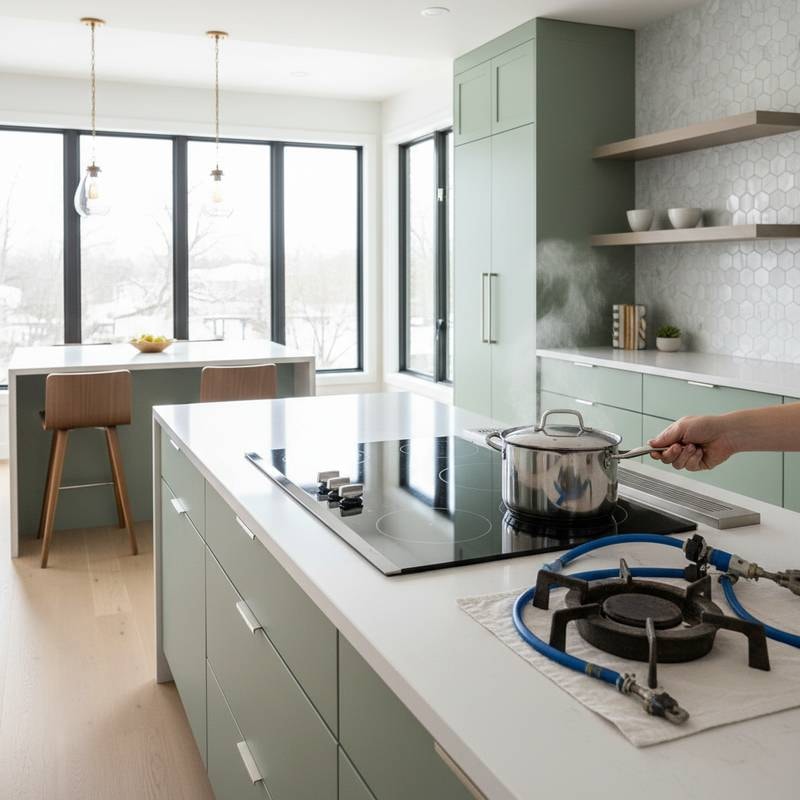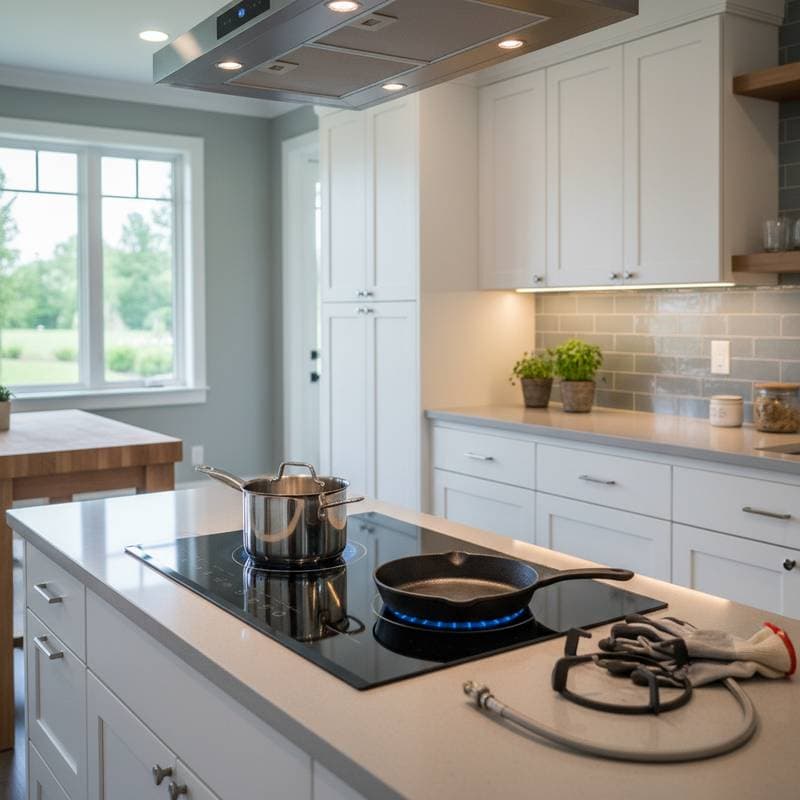Why Induction Replaces Gas in Kitchen Remodels
As a remodeling contractor, I observe homeowners transitioning from gas to induction cooktops in kitchen remodels with greater frequency. This shift stems from priorities beyond novelty: safety, efficiency, and sustained cost management. In older residences, gas systems frequently generate complications that outweigh their conveniences. Once individuals grasp the comprehensive implications, induction emerges as the superior choice for modernization.
The Hidden Costs of Retaining Gas
Numerous homeowners believe that maintaining gas infrastructure spares them the need for electrical modifications or panel enhancements. They overlook how deteriorating gas lines, obsolete ventilation systems, and carbon monoxide hazards impose substantial future expenses. Each gas appliance requires airflow, and inadequate kitchen ventilation leads to the ongoing removal of combustion byproducts that produce unnecessary pollutants.
I have addressed numerous instances of partially corroded gas lines exhibiting minor leaks. Such repairs prove costly, and homeowners ultimately incur double expenditures: initial fixes for gas issues followed by conversion to electric systems. During retrofit planning, I advise clients that any open flame in the kitchen elevates long-term maintenance obligations and insurance premiums. Proactive evaluation of these factors prevents avoidable financial burdens.
Why Induction Offers Practical Advantages
Induction cooking employs magnetic fields to heat cookware directly, bypassing ambient air warming. Consequently, kitchens remain cooler, cookware achieves higher temperatures more quickly, and energy consumption decreases. Contemporary induction models achieve over ninety percent efficiency, while gas systems typically operate below fifty percent. This disparity results in reduced utility bills and diminished ventilation demands.
In remodeling contexts, induction enhances design simplicity. No exhaust for combustion gases is necessary, allowing cooktop placement in diverse locations supported by sufficient electrical circuits. Clients often appreciate the seamless, integrated appearance of induction surfaces combined with concealed, ductless ventilation units. Such configurations enable spatial arrangements unattainable with traditional gas installations, fostering innovative kitchen layouts.
Addressing Common Concerns with Effective Solutions
Certain homeowners delay adoption due to worries about cookware compatibility. In practice, the majority of stainless steel and cast iron items function seamlessly with induction. A straightforward magnet test confirms suitability: if the magnet adheres to the pan base, it is compatible. For materials such as copper or aluminum, affordable induction interface discs provide a reliable adaptation method without requiring full replacements.
Upfront electrical expenses also deter some individuals. A dedicated circuit or additional breaker may be required, representing a singular investment. Consider this against the cumulative costs of gas line upkeep, carbon monoxide monitoring devices, and routine professional vent servicing. In the long term, the electrical approach prevails in both economic and ecological terms, yielding measurable returns over years of use.
Health and Safety Benefits of Induction
Having worked extensively in completed kitchens, I detect improvements in air quality right away. Gas burners emit nitrogen dioxide, carbon monoxide, and additional byproducts that persist without flawless ventilation. Induction eliminates open flames, off-gassing, and carbon monoxide accumulation risks entirely. For households including children, elderly members, or those with respiratory sensitivities, these attributes hold significant value.
Induction surfaces maintain lower temperatures since heat concentrates in the cookware alone. Clients with young children frequently cite this as their primary motivation for switching. Incidents of accidental burns decrease substantially, and cleanup simplifies as spills avoid hardening on the surface. These features contribute to a safer, more user-friendly cooking environment overall.
How to Prepare for a Gas-to-Induction Con. Assess your electrical panel. Engage a licensed electrician to verify capacity for the additional load. A new circuit often suffices, though a complete service upgrade remains rare.
-
Cap or remove the gas line. Employ a qualified plumber to disconnect and secure the line correctly. Avoid leaving any gas connection exposed or improperly sealed.
-
Plan for ventilation adjustments. Consider reducing range hood size or adopting a recirculating model, as induction generates minimal heat and steam compared to gas.
-
Update your countertop cutout. Verify that the induction unit aligns with existing openings, but measure precisely prior to purchase to ensure a flawless fit.
Integrating Induction for Optimal Kitchen Performance
Induction cooktops transcend aesthetic appeal; they represent a functional enhancement that elevates efficiency, safety, and adaptability in kitchen remodels. When clients inquire about my personal preference, I recommend induction without hesitation. It mitigates combustion dangers, streamlines upkeep, and optimizes energy consumption, delivering lasting value to any home.









